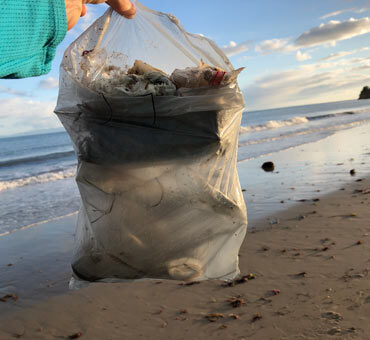Fresh air and clean beaches are good for all of us. So why not do a beach clean-up!
Runoff from the land picks up trash and other pollutants and flows down storm drains and straight to the Channel. Unlike sewage, this polluted runoff is not filtered and treated before it hits the ocean. The trash that gets transported to the ocean can be mistaken as food by wildlife or entangle animals. Help keep wildlife safe by picking up trash before it can cause harm.
Volunteer clean-up efforts play an important role keeping our beaches clean. While our local beaches may appear relatively clean due to routine beach grooming, microplastics are plentiful. These tiny plastic particles not only harm wildlife, they can be consumed by fish and enter the food chain, posing a threat to human health. So be on the lookout for tiny plastic bits!
Here are some helpful instructions on how to do a clean-up AND contribute to Channelkeeper’s ever-growing database of trash collected from local beaches—data that we use to help inform policy-making. Follow these simple instructions to get outside and make a difference in your community.
- Gather supplies before you go. Coat up with sunscreen and grab a reusable bucket or bag, a durable pair of gloves, and your trusty water bottle and head outside.
- Download our Clean-up Data Sheet. Print out our Data Card and bring it (and a pencil) along with you. We recommend filling out the data card as you go. Please also note that not every item you find on the beach will be on the data card. Some items of particular interest include cigarette filters, micro-pieces of foam and plastic, and balloons.
- Beach Clean-up. Pick up any litter you see on the beach and stay safe while out. Do not pick up sharp items. If you feel unsafe picking up an item, please leave it where you found it. While it’s rare to find medical waste such as needles, these are occasionally found, and broken glass is prevalent. These should not be picked up by volunteers.
- Get help for injured critters. If you see a dead or injured bird, please don’t pick it up. Notify Santa Barbara Wildlife Care Network at 805.966.9005. If it’s a dead or sick marine mammal, please contact Channel Islands Marine & Wildlife Institute at 805.567.1505 and leave a message with as much info as possible about the animal and its location.
- Share the fun! Don’t forget to post your clean-up pics and results on social media using the hashtag #SBChannelkeeper and tagging us @SBChannelkeeper. We can’t wait to see your trash treasures and give you some well-deserved kudos for volunteering to protect the outdoor places we all love.
Enrichment:
Learn the facts about plastic pollution and checkout ten tips on how to reduce plastic with your family
What are the top trash items found by volunteers at beach clean-ups around the world? Guess and then find the answer the Ocean Conservancy’s International Coastal Clean-up Report 2019.
Become a part of a thriving community interested in reducing waste from single-use plastic products and packaging and show your support for plastic reduction policies by signing this petition urging Congress to hold plastic producers accountable.

